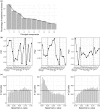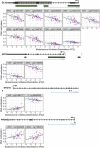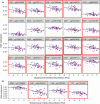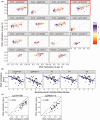Children's biobehavioral reactivity to challenge predicts DNA methylation in adolescence and emerging adulthood
- PMID: 30176105
- PMCID: PMC6433477
- DOI: 10.1111/desc.12739
Children's biobehavioral reactivity to challenge predicts DNA methylation in adolescence and emerging adulthood
Abstract
A growing body of research has documented associations between adverse childhood environments and DNA methylation, highlighting epigenetic processes as potential mechanisms through which early external contexts influence health across the life course. The present study tested a complementary hypothesis: indicators of children's early internal, biological, and behavioral responses to stressful challenges may also be linked to stable patterns of DNA methylation later in life. Children's autonomic nervous system reactivity, temperament, and mental health symptoms were prospectively assessed from infancy through early childhood, and principal components analysis (PCA) was applied to derive composites of biological and behavioral reactivity. Buccal epithelial cells were collected from participants at 15 and 18 years of age. Findings revealed an association between early life biobehavioral inhibition/disinhibition and DNA methylation across many genes. Notably, reactive, inhibited children were found to have decreased DNA methylation of the DLX5 and IGF2 genes at both time points, as compared to non-reactive, disinhibited children. Results of the present study are provisional but suggest that the gene's profile of DNA methylation may constitute a biomarker of normative or potentially pathological differences in reactivity. Overall, findings provide a foundation for future research to explore relations among epigenetic processes and differences in both individual-level biobehavioral risk and qualities of the early, external childhood environment.
© 2018 John Wiley & Sons Ltd.
Figures





Similar articles
-
Early father involvement moderates biobehavioral susceptibility to mental health problems in middle childhood.J Am Acad Child Adolesc Psychiatry. 2006 Dec;45(12):1510-20. doi: 10.1097/01.chi.0000237706.50884.8b. J Am Acad Child Adolesc Psychiatry. 2006. PMID: 17135997
-
Epigenetic status in the offspring of spontaneous and assisted conception.Hum Reprod. 2014 Jul;29(7):1452-8. doi: 10.1093/humrep/deu094. Epub 2014 May 8. Hum Reprod. 2014. PMID: 24812310
-
Association of Neighborhood Disadvantage in Childhood With DNA Methylation in Young Adulthood.JAMA Netw Open. 2020 Jun 1;3(6):e206095. doi: 10.1001/jamanetworkopen.2020.6095. JAMA Netw Open. 2020. PMID: 32478847 Free PMC article.
-
The role of epigenetics for understanding mental health difficulties and its implications for psychotherapy research.Psychol Psychother. 2019 Jun;92(2):190-207. doi: 10.1111/papt.12227. Epub 2019 Mar 28. Psychol Psychother. 2019. PMID: 30924323 Review.
-
The epigenetics of perinatal stress .Dialogues Clin Neurosci. 2019 Dec;21(4):369-378. doi: 10.31887/DCNS.2019.21.4/mszyf. Dialogues Clin Neurosci. 2019. PMID: 31949404 Free PMC article. Review.
Cited by
-
Associations Among Parental Caregiving Quality, Cannabinoid Receptor 1 Expression-Based Polygenic Scores, and Infant-Parent Attachment: Evidence for Differential Genetic Susceptibility?Front Neurosci. 2021 Jul 27;15:704392. doi: 10.3389/fnins.2021.704392. eCollection 2021. Front Neurosci. 2021. PMID: 34385904 Free PMC article.
References
-
- Alisch, R. S. , Chopra, P. , Fox, A. S. , Chen, K. , White, A. T. J. , Roseboom, P. H. , … Kalin, N. H. (2014). Differentially methylated plasticity genes in the amygdala of young primates are linked to anxious temperament, an at risk phenotype for anxiety and depressive disorders. The Journal of Neuroscience: The Official Journal of the Society for Neuroscience, 34(47), 15548–15556. 10.1523/JNEUROSCI.3338-14.2014 - DOI - PMC - PubMed
-
- Alkon, A. , Goldstein, L. H. , Smider, N. , Essex, M. J. , Kupfer, D. J. , Boyce, W. T. , & The MacArthur Assessment Battery Working Group . (2002). Developmental and contextual influences on autonomic reactivity in young children. Developmental Psychobiology, 42(1), 64–78. 10.1002/dev.10082 - DOI - PubMed
Publication types
MeSH terms
Substances
Grants and funding
LinkOut - more resources
Full Text Sources
Other Literature Sources
Miscellaneous

